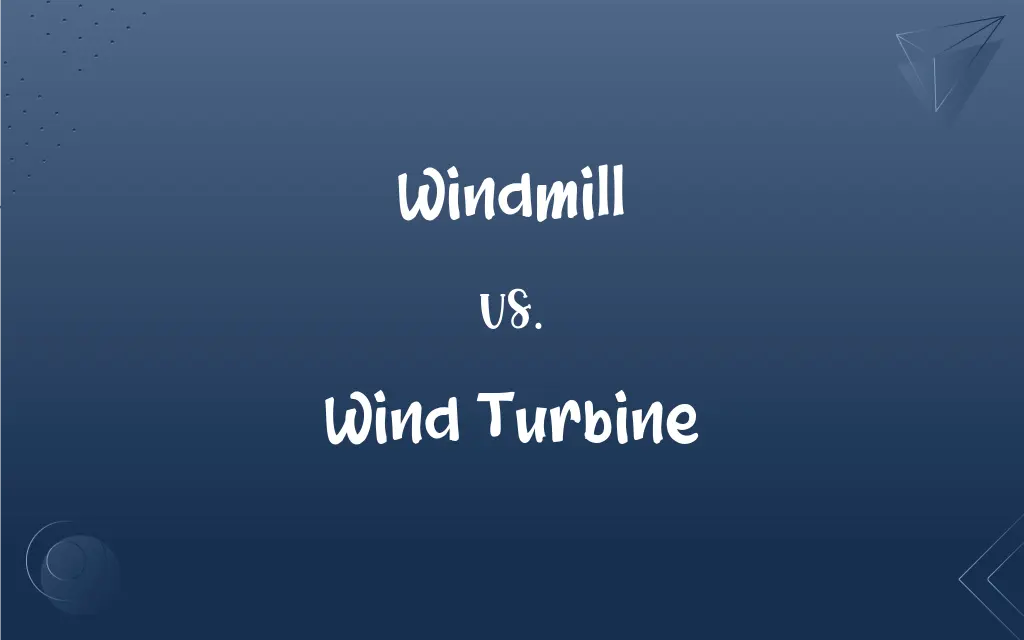Windmill vs. Wind Turbine: What's the Difference?
Edited by Harlon Moss || By Janet White || Updated on October 26, 2023
A windmill uses wind to power mechanical processes like grinding, while a wind turbine converts wind into electricity.

Key Differences
Windmills have been around for centuries and were primarily designed to perform mechanical work, such as grinding grain or pumping water. Wind turbines, on the other hand, are a more recent innovation intended to harness the wind's kinetic energy to produce electricity.
Historically, windmills have been characterized by their large wooden or metal blades and their primary use in agricultural settings. Wind turbines, in contrast, often feature sleeker, more aerodynamic blades made of lightweight materials and are typically associated with power generation for broader grids or homes.
The design of a windmill typically centers around its main function. For instance, a grain-grinding windmill may have a mechanism that converts the rotational movement of its blades into the up-and-down movement of a pestle. Wind turbines are designed with generators that convert the rotation of the blades into electrical energy, which is then fed into a power grid.
One significant visual distinction between windmills and wind turbines is their size and structure. Windmills are generally smaller and may have a more quaint, historical appearance. Wind turbines, especially those used in commercial energy production, are much larger, towering structures with a modern look.
Lastly, while windmills are often remembered as iconic structures dotting rural landscapes, particularly in places like the Netherlands, wind turbines are symbols of modern renewable energy efforts, seen in large numbers at wind farms worldwide.
ADVERTISEMENT
Comparison Chart
Primary Purpose
Mechanical work (e.g., grinding or pumping)
Electricity generation
Historical Usage
Centuries old, especially in agriculture
More recent, aligned with renewable energy initiatives
Blade Design
Broader, less aerodynamic
Sleek, aerodynamic
Size & Appearance
Generally smaller, historical look
Larger, modern appearance
Associated Image
Rural landscapes, especially in the Netherlands
Modern wind farms worldwide
ADVERTISEMENT
Windmill and Wind Turbine Definitions
Windmill
Windmills are often characterized by their large, broad blades.
The windmill's blades turned slowly in the gentle breeze.
Wind Turbine
Wind turbines can be standalone or part of larger wind farms.
The homeowner installed a wind turbine to reduce electricity bills.
Windmill
A windmill is a structure that uses wind to power mechanical processes.
The old windmill was used to grind grain for the village.
Wind Turbine
Wind turbines are central to renewable energy efforts.
The new wind farm consisted of 50 wind turbines.
Windmill
Windmills can be used for various tasks, including pumping water.
The farmer used the windmill to pump water for his cattle.
Wind Turbine
A wind turbine is a device that converts wind's kinetic energy into electricity.
The wind turbine provided power to the entire community.
Windmill
Windmills have historical significance in many cultures.
Windmills are a defining feature of the Dutch countryside.
Wind Turbine
Wind turbines contribute to sustainable, clean energy production.
With the addition of wind turbines, the city moved closer to its green energy goals.
Windmill
Windmills convert wind energy into rotational energy.
The windmill's rotation powered the attached machinery.
Wind Turbine
Wind turbines have aerodynamic blades attached to a generator.
The wind turbine's blades spun rapidly in the strong wind.
Windmill
A machine that runs on the energy generated by a wheel of adjustable blades or slats rotated by the wind.
Windmill
Something, such as a toy pinwheel, that is similar to a windmill in appearance or operation.
Windmill
To move or cause to move like the wheel of a windmill; rotate sweepingly.
Windmill
A machine which translates linear motion of wind to rotational motion by means of adjustable vanes called sails.
Windmill
The structure containing such machinery.
Windmill
A child's toy consisting of vanes mounted on a stick that rotate when blown by a person or by the wind.
Windmill
(basketball) A dunk where the dunker swings his arm in a circular motion before throwing the ball through the hoop.
Windmill
(baseball) A pitch where the pitcher swings his arm in a circular motion before throwing the ball.
Windmill
A guitar move where the strumming hand mimics a turning windmill.
Windmill
A breakdancing move in which the dancer rolls his/her torso continuously in a circular path on the floor, across the upper chest, shoulders and back, while twirling the legs in a V shape in the air.
Windmill
Any of various muscle exercises in which a large deal of the body makes a great circle, typically one where a kettlebell is raised overhead and the torso is rotated to the other side with the hand reaching its foot (hitting the core, glutes, hamstrings, trapezius, rhomboids, deltoids and rotator cuffs) but sometimes even a windshield wiper.
Windmill
Any of various large papilionid butterflies of the genus Byasa, the wings of which resemble the vanes of a windmill.
Windmill
(juggling) The false shower.
Windmill
(metaphorical) An imaginary enemy, but presented as real.
Windmill
To rotate with a sweeping motion.
She ran down the hill, windmilling her arms with glee.
Windmill
(intransitive) Of a rotating part of a machine, to (become disengaged and) rotate freely.
The axle broke and the wheel windmilled in place briefly before careening through the wall.
Windmill
A mill operated by the power of the wind, usually by the action of the wind upon oblique vanes or sails which radiate from a horizontal shaft.
Windmill
A mill that is powered by the wind
Windmill
Generator that extracts usable energy from winds
FAQs
Are windmills used for electricity generation?
Traditionally, windmills were used for mechanical processes, but some modern versions can generate electricity.
How tall can wind turbines get?
Modern commercial wind turbines can reach heights of over 500 feet.
What is a windmill?
A windmill is a structure that harnesses wind energy for mechanical tasks like grinding or pumping.
How does a wind turbine work?
A wind turbine converts the kinetic energy from wind into electricity using a generator.
What's the lifespan of a wind turbine?
A typical wind turbine's lifespan is around 20-25 years.
How much electricity can a wind turbine produce?
Output varies, but a modern 2.5MW turbine can produce over 6 million kWh annually in optimal conditions.
Why do wind turbines have three blades?
Three blades offer a balance of efficiency, cost, and dynamic stability.
Are windmills and wind turbines the same?
No, while both harness wind energy, windmills focus on mechanical processes and wind turbines on electricity generation.
How are windmills maintained?
Regular inspections and maintenance ensure functionality and longevity.
Why are windmills associated with the Netherlands?
The Netherlands historically used windmills for tasks like draining land, grinding grain, and sawing lumber.
Can you have a windmill in your backyard?
Yes, but its feasibility and effectiveness depend on local wind conditions and regulations.
Can wind turbines operate in any weather?
No, extremely high winds or icy conditions can cause turbines to shut down for safety.
Can windmills be used in urban settings?
Space and wind conditions can be limiting factors, but some urban installations do exist.
Where were windmills first invented?
The earliest windmills were believed to be in Persia (modern-day Iran) in the 7th century AD.
Do wind turbines harm birds?
Some birds are at risk, but proper site selection and design can minimize impacts.
How much does a wind turbine cost?
Prices vary, but commercial turbines can cost millions, while smaller residential ones might be tens of thousands.
Is the energy from windmills and wind turbines clean?
Yes, both produce energy without emitting greenhouse gases.
Why are windmills often seen near water?
Historically, many windmills were used to pump water or drain lands.
How efficient are wind turbines?
Modern turbines convert up to 50% of the wind's kinetic energy into electricity.
What are the environmental impacts of wind turbines?
While cleaner than fossil fuels, they can affect local ecosystems, but proper planning can mitigate most concerns.
About Author
Written by
Janet WhiteJanet White has been an esteemed writer and blogger for Difference Wiki. Holding a Master's degree in Science and Medical Journalism from the prestigious Boston University, she has consistently demonstrated her expertise and passion for her field. When she's not immersed in her work, Janet relishes her time exercising, delving into a good book, and cherishing moments with friends and family.
Edited by
Harlon MossHarlon is a seasoned quality moderator and accomplished content writer for Difference Wiki. An alumnus of the prestigious University of California, he earned his degree in Computer Science. Leveraging his academic background, Harlon brings a meticulous and informed perspective to his work, ensuring content accuracy and excellence.































































